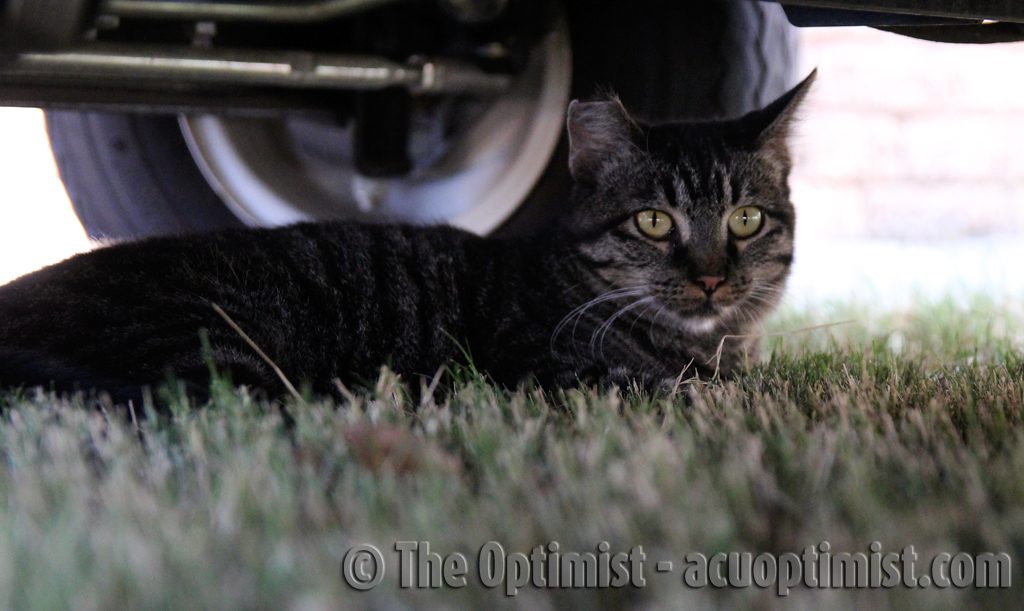Now in its third year, the university’s Feral Cat Initiative has trapped, neutered and released 100 cats.
Started in spring 2013, the initiative is part of the Department of Facilities and Campus Management’s goal to create a more sustainable cat population on campus. At present, 63 known cats live on campus, with five new litters born during the summer.
Corey Ruff, executive director of facilities and campus management, said ACU has a “vacuum effect” on the surrounding feline population.
“We have a food source, we have folks who are feeding them, too; but they’re just naturally going to be drawn to areas like this,” he said.
Facilities and Campus Management teamed up with Dr. Dale Hembree, local veterinarian and adjunct professor in the Department of Agricultural and Environmental Studies, on the TNR part of the initiative.
Hembree and his pre-vet students are responsible for spaying/neutering, vaccinating and marking the cats once they are brought to the clinic. Females get a mark on their right ear, whereas males are marked on their left.
Though options for a TNR program during summer are being explored, facilities and campus management put the program on hold this summer, which resulted in a small growth in the number of cats that have yet to go through the TNR program.
Gayenell Rainwater, landscape manager, is in charge of the second phase of the initiative. Dubbed the “cat lady” by her coworkers, Rainwater takes on the daily task of feeding each cat about two ounces of food.
“There are very specific feeding requirements to go and encourage the cats to go and do what they were meant to do,” she said. “It’s enough to keep them healthy, but enough to keep them motivated to hunt.”
Four feeding stations are dispersed on campus, in the facilities central plant between the Onstead-Packer Biblical Studies Building and College of Business Administration Building, behind McDonald Hall, in the alley behind the Don Morris Building and outside the Zona Luce Building.
Although the cat population might appear to have increased, the number has decreased by about 4o individuals, Ruff said.
Rainwater said the location of the facilities central plant feeding station could be to blame, with the area specifically sculpted for the cats in one of the busiest areas on campus. She said about 15 or 20 cats can be seen in the morning waiting for their meal.
Ruff asks students to refrain from feeding the cats or taking them into the dorm, regardless of how friendly a cat might be.
“I think sometimes students think it’s a health issue if a cat looks a little leaner. They’re not house cats, I guess is what I’m trying to say, they need to be a little leaner,” he said. “They’re here to keep the rat and vermin population down.”
As for the future of the cats, it looks like they’re here to stay. Ruff said the university once considered getting rid of them, but soon brought the felines back.
“At one point they tried to completely eradicate all the cats from campus, and we had a huge mouse infestation on campus, so they do serve a purpose,” he said. “That’s why we’re trying to establish a healthy, sustainable population on campus.”
Of course, some cats and kittens cannot survive the feral cat lifestyle.
Rainwater said she’s adopted two herself, one abandoned by its mother and another born without a foot, but the initiative workers have someone to call for assistance to rehab the sickly kittens.
Additionally, some cats are sent out to become barn cats and hunt vermin for farmers in the area.
Ruff said the Feral Cat Initiative usually sets up a booth in the Campus Center for national feral cat day, Oct. 16 this year, where students can learn more and get involved.
In the meantime, students can check out the cats on Twitter at @ACUFeralCats, which tweets pictures of the cats and some of their stories daily.

